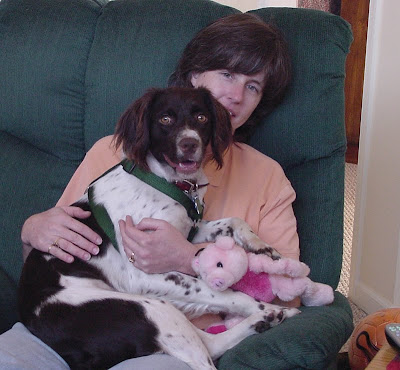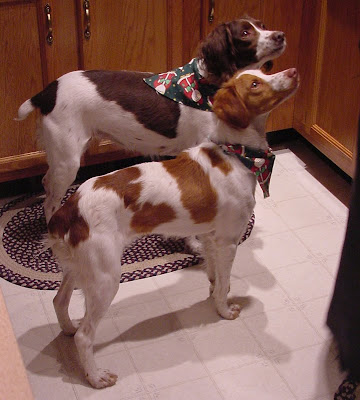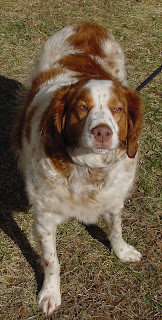CeCe is the primary reason we have stayed involved in the rescue effort. We don’t do nearly as much as some people, but we do what we can. We have fostered dogs, helped transport dogs and have even pulled dogs out of area shelters (when asked).
One of the things I try to help with is the gift-wrapping effort during the holiday season. American Brittany Rescue (ABR) volunteers organize and staff gift-wrapping tables for various merchants across the United States. Not just to raise money, which is always welcome, of course, but to spread the word about rescue.
trying to get him to pose for me. Andrea volunteers a huge chunk of her time doing a wide
variety of work for ABR, including coordinating the efforts in several states.
 You’d be surprised how many people know very little about dog rescue. Many people believe the SPCA and animal shelters are the only places you can go to adopt a homeless pet. They don’t know about breed-specific rescue groups like ABR and the National Brittany Rescue and Adoption Network (NBRAN). Not to mention the many groups that take in all kinds of dogs, cats and other critters in need of homes.
You’d be surprised how many people know very little about dog rescue. Many people believe the SPCA and animal shelters are the only places you can go to adopt a homeless pet. They don’t know about breed-specific rescue groups like ABR and the National Brittany Rescue and Adoption Network (NBRAN). Not to mention the many groups that take in all kinds of dogs, cats and other critters in need of homes.
 The conversations I and fellow volunteers have with people during these events is what I enjoy most. I really hate the begging for donations part, but someone has to do it.
The conversations I and fellow volunteers have with people during these events is what I enjoy most. I really hate the begging for donations part, but someone has to do it.
Here are some of the common questions we get:
1. What is a Brittany? (It’s sort of an uncommon breed. The answer is long, so you’ll have to CLICK HERE if you really want to know.)
2. Are all of these dogs [in the pictures around the gift wrapping table] available for adoption? (Not now, but they were at one time.)

3. Is this dog available for adoption? (Sometimes we take real, live ambassadors along, as shown in the picture above. It could be a foster dog, or, as with Bodie, they are former fosters who have been adopted.)
 4. Why just focus on one breed? Why not help all dogs? (There are actually a lot of breed-specific rescue groups. As the ABR Web site explains… ABR began “as a cooperative effort of Brittany owners, breeders, trialers and fanciers who believe we have a responsibility not only for our own dogs and the dogs we produce, but for our breed as a whole. Because many rescue dogs can be traced 1-3 generations back to a recognized breeder, we believe all breeders should take it upon themselves to assist Brittanys in need.” Breed-specific groups like ABR, NBRAN and other organizations specializing in dogs of one breed, are great places to get dogs because they know so much about the overall traits and characteristics of that particular breed.)
4. Why just focus on one breed? Why not help all dogs? (There are actually a lot of breed-specific rescue groups. As the ABR Web site explains… ABR began “as a cooperative effort of Brittany owners, breeders, trialers and fanciers who believe we have a responsibility not only for our own dogs and the dogs we produce, but for our breed as a whole. Because many rescue dogs can be traced 1-3 generations back to a recognized breeder, we believe all breeders should take it upon themselves to assist Brittanys in need.” Breed-specific groups like ABR, NBRAN and other organizations specializing in dogs of one breed, are great places to get dogs because they know so much about the overall traits and characteristics of that particular breed.)

5. Why is it so important to know the traits and characteristics? Isn’t a dog a dog? (Nope. Dogs were bred for specific purposes and, as a result, tend to exhibit certain behaviors people should really be aware of before adopting a dog. Brittanys, for example, tend to be very energetic and need lots of exercise. They are people dogs and don’t always do well when left alone for long periods. They are also hunting dogs and some have pretty strong prey drives, so you’d want to make sure they are cat-friendly, for example, before placing them in a home with a cat.)
6. How do you know if a dog is cat-friendly? Don’t all dogs chase cats? (To an extent, yes. But there’s a huge difference between being interested in what a cat is doing/wanting to play with a cat and wanting to EAT a cat. The latter is not cat-friendly.)
 7. Aside from giving money, what else can we do to help? (Rescue groups are almost always in need of foster homes. That’s where a dog lives with you and you feed, love and keep it safe, teach it good doggy manners, etc., until a home becomes available. You can agree to make phone calls to check with veterinarians of potential adopters. You can do home visits when there’s a potential adopter in your area.)
7. Aside from giving money, what else can we do to help? (Rescue groups are almost always in need of foster homes. That’s where a dog lives with you and you feed, love and keep it safe, teach it good doggy manners, etc., until a home becomes available. You can agree to make phone calls to check with veterinarians of potential adopters. You can do home visits when there’s a potential adopter in your area.)
Of course, donations are never bad and are almost always needed. Which (finally!) brings me to the point of this post. You can…
Bringing A Dog Into Your Home.



Great write up!!! Kelly M